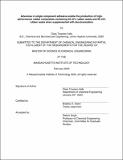Advances in single component adhesive enable the production of high-performance rubber composites containing 40 wt% rubber waste and 95 wt% rubber waste when supplemented with devulcanization
Author(s)
Troyano-Valls, Clara
DownloadThesis PDF (1.512Mb)
Advisor
Olsen, Bradley D.
Terms of use
Metadata
Show full item recordAbstract
Tire waste management is a significant and unsolved issue that continues to threaten human and environmental health. Here, a single component adhesive developed by our group is further optimized to produce rubber composites containing 40 wt% recycled rubber crumb and an unused polybutadiene matrix. The best-performing 40 wt% samples outperform those produced in the previous study, and which only contain 15 wt% recycled content. To push the recycled content in the composite even further, the single component adhesive was combined with devulcanization to produce a 95 wt% sample that also outperforms the 15 wt% samples from the predecessor study. Finally, scanning electron microscopy and elemental mapping enabled a new understanding of the architecture of the composites, and shows that the adhesive is not acting as a coating to the rubber crumb, but is instead shearing off substantially and distributing itself in the composite.
Date issued
2023-02Department
Massachusetts Institute of Technology. Department of Chemical EngineeringPublisher
Massachusetts Institute of Technology